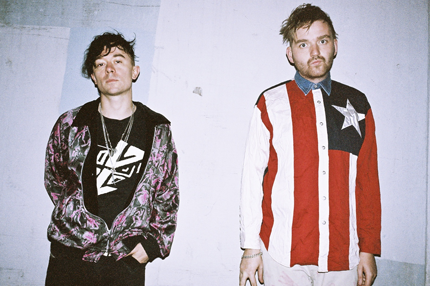London pop-punkers the Big Pink took some time to “reflect on the good times” after 2009’s A Brief History of Love and poured the results into their second album Future This, due January 17 via 4AD. The disc includes “Hit the Ground (Superman),” a Laurie Anderson-sampling bulldozer that Zane Lowe just premiered on his show BBC Radio 1 show. SPIN has an exclusive look at the LP’s art and a full track list, as well as some insight into what went into making the album from Milo Cordell.
What did the band learn most from releasing your debut?
It’s tough. I’d never been in a band before until the Big Pink. I think we learned that we really just wanted to make a record that’s fun. I think that first record wasn’t fun. It had a negative energy within it. So going out to play those songs for a year and a half afterwards made us wish that we had something positive to put over. We just tried to make something more positive, more upbeat, something more fun to dance to. From all that touring, we could see the bits that make people happy. Lyrically, I think we made a conscious decision to make things very simple. We want to tell stories, but quite short and from the heart.
You’ve described the Big Pink as a commercial pop band.
I think what attracts Robbie [Furze] and me to making music period is pop music. Whether it’s Britney Spears or Aaliyah or Nirvana or Smashing Pumpkins, it’s all pop music. I think they all made big, conscious pop records and I think we’ve done the same. We wanted to have our feet in the bits of the first record that we really like — the bigness of “Dominos” and the heart and sincerity of “Velvet” — and then more so. Take the best songs from that record magnify and mix them.
Are there songs on this record that stand out to you just as much as “Dominos” and “Velvet”?
My favorite song is called “Palace.” We worked with samples a lot on this record, which we’ve never really done before, and we had to clear three or four: “Hit the Ground (Superman)” has got a Laurie Anderson sample, “Give it Up” has an old soul sample in it by Ann Peebles, “Lose Your Mind” actually has a sample from Siouxsie and the Banshees in it. And “The Palace” samples the theme from True Romance, that weird kind of swing. All that created a vibe because those are very powerful samples. When you take those out, you’re left with a song you wouldn’t have come up with if that sample hadn’t been the starting off point. It was a different form of inspiration. The first time out, we used to have movies on in the background and have those in our mind as we wrote. This time, the sample was our movie and we got our energy and vibe there. We’d either keep it in there or we chucked them.
This sounds like music that could complement visuals really well.
Anyone who’s in a studio works with a lot of images, sticking up pictures. I was just reading an interview with Beirut and he literally worked at a computer in his room from pictures he had torn out of books or magazines for inspiration. We did that a lot with the first record. It was very visual and whatever image we had there with us always helped define the song in a way.
How do you think the fundamental differences between a sample and a snippet of a film might affect the writing of the record?
From a film or image, you’re drawing from a visual feeling, whether it’s the sadness in someone’s eyes. But there’s more energy in a sample, because it’s constantly moving, whereas a still image is static. I think the movement in the sample is key. I think the average BPM on this so record is so much higher than anything we’ve done before.
How much, if at all, did you tweak the way you approached recording to accommodate a shift like that?
To begin with actually, we knew we didn’t want any live drums. Robbie was like, “I can’t be bothered to pick up a guitar.” So we just started using synths to create drones. We learned how to play piano, which he hadn’t done — before we were just kind of finding keys. We also worked with a producer, Paul Epworth, who had worked on “Dominos” and couple of the other singles. We went ’round to his house and into the studio thinking he’d just do a few of the songs but after halfway through, he was like, “You know what, I’ll do the whole thing.” All of the songs were done by the time we went into the studio, but we made everything sound a lot better just through his equipment and his ear. The first record we recorded at Electric Lady in New York. It was so grand and so big, and just the two of us in there, producing it ourselves not really knowing what we were doing but with the best of intentions. This time, we did it with a great producer in his home studio. I think we did it the wrong way around. I said to someone recently that this feels like our debut, and the last was our difficult second album.
Future This Track List:
“Stay Gold”
“Hit The Ground (Superman)”
“Give It Up”
“The Palace”
“1313”
“Rubbernecking”
“Jump Music”
“Lose Your Mind”
“Future This”
“77 “





